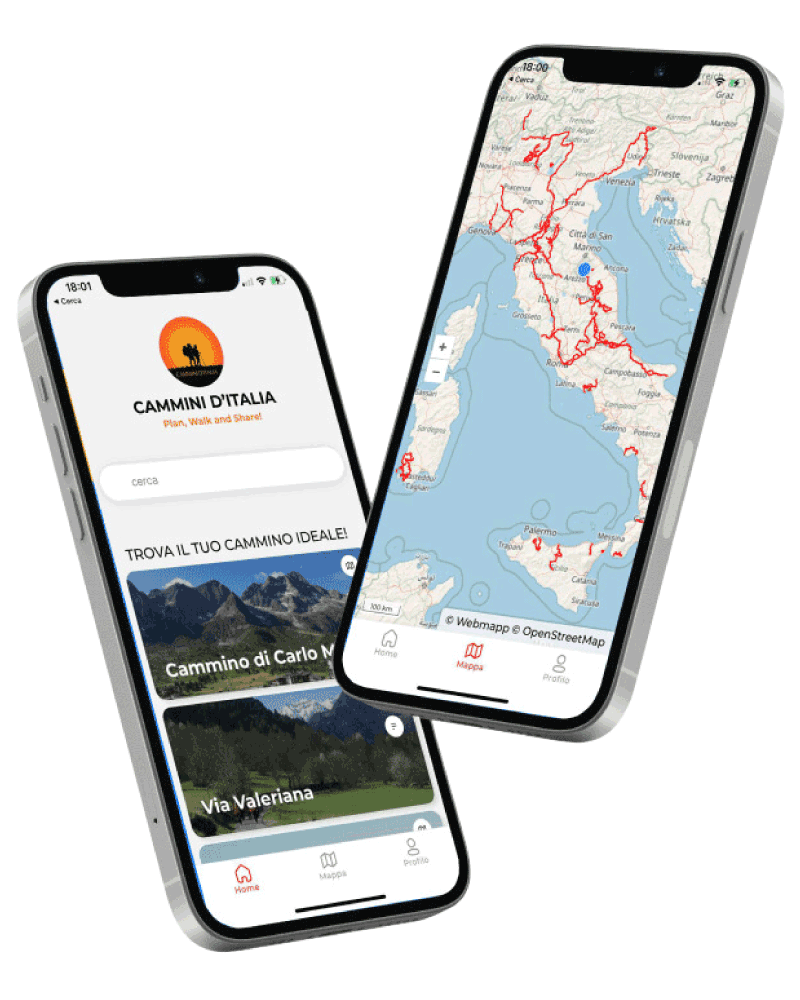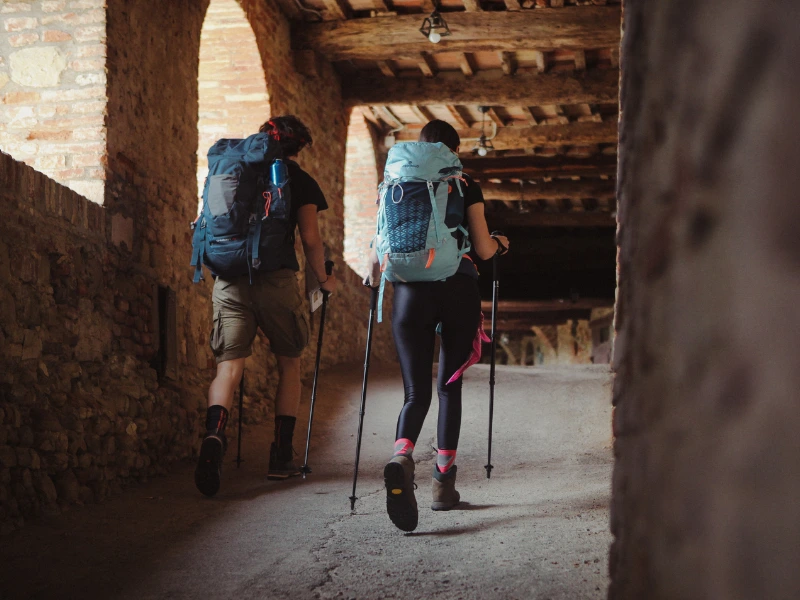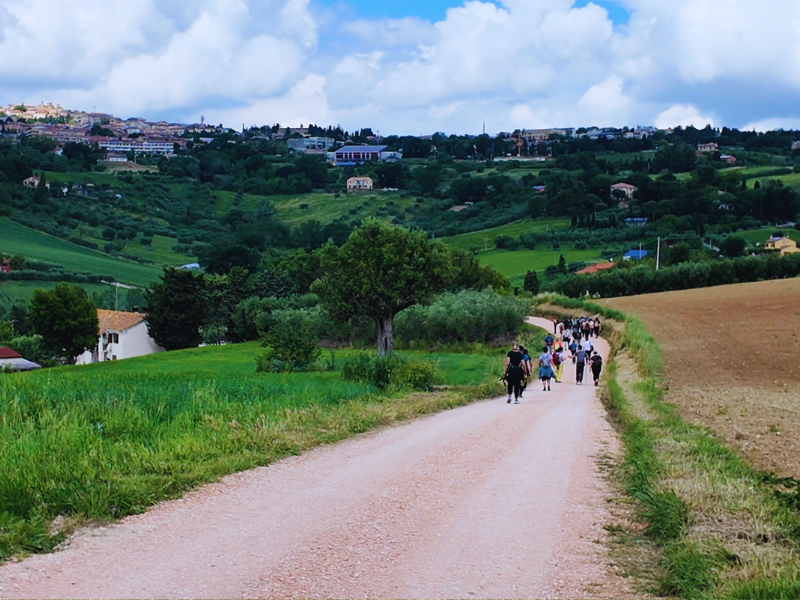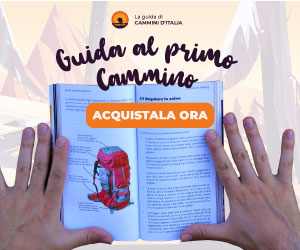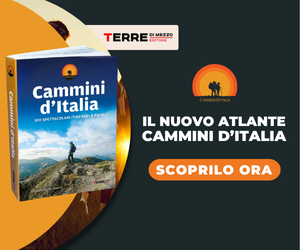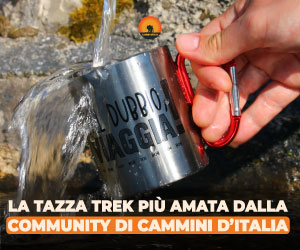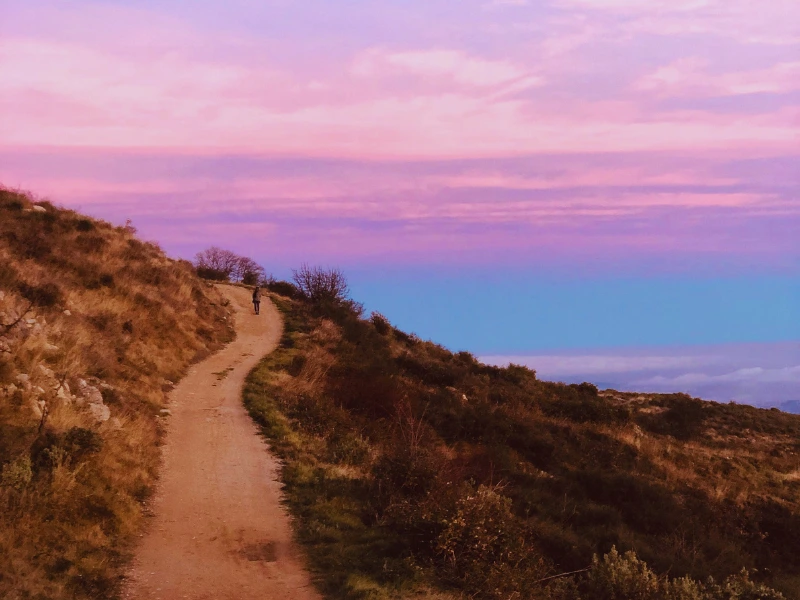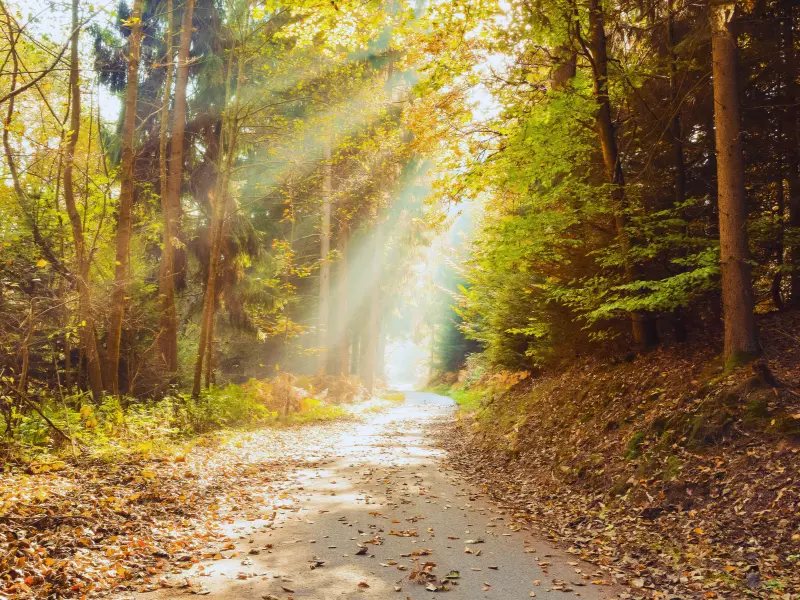
Cammino di San Benedetto
Three hundred kilometers from Norcia, at the foothills of the Sibillini Mountains, to Subiaco, in the upper Aniene Valley, to Cassino, in the Liri Valley, passing through the most significant places in the life of St. Benedict of Norcia.
An extraordinary 300-kilometer journey connecting Norcia, birthplace of St. Benedict, to Montecassino, where the saint founded the famous abbey. It traverses Umbria and Lazio, exploring places symbolic of Benedictine spirituality and touching on the breathtaking landscapes of the central Apennines.
Consisting of 16 STAGES, the path winds through paths, cart tracks and low-traffic roads, crossing lush valleys and striking mountains. In addition to immersing oneself in the Benedictine tradition, the route offers a unique opportunity to learn about other important places of worship linked to saints such as Rita of Cascia, Francis of Assisi and Thomas Aquinas, as well as lesser-known figures, including Giuseppe da Leonessa and Agostina Pietrantoni.
Ideal for those seeking an experience of faith, culture and nature, Cammino di San Benedetto can be traveled on foot or by bicycle, in a single adventure or divided into several STAGEs. Each step is an invitation to discover the spiritual and scenic beauty of central Italy, in a journey that celebrates simplicity, reflection and contact with nature.
Data Sheet
-
Length:
307 km -
Stages:
16 -
Average elevation gain:
470 m -
Departure:
Norcia -
Arrival:
Montecassino
HISTORY
The Cammino is dedicated to St. Benedict of Norcia, founder of Western monasticism and patron saint of Europe.
The route offers pilgrims the chance to take a unique spiritual and experiential journey, getting to know some of the most interesting Benedictine abbeys in Italy, along with places rich in art among fascinating landscapes, and allows them to get to know an authentic Italy of traditions, hospitality and excellent cuisine.
WATER SOURCES.
Water sources are available along Cammino di San Benedetto for each STAGE.
SERVICES
The Camino runs in mountainous areas, mostly through villages and small towns. At each STAGE there are multiple lodging options, one or more grocery stores, and at least one pharmacy. In contrast, ATMs are not always available, and not all facilities are equipped with POS: so it is suggested to bring a cash reserve.
SIGNAGE
There are 55×15 cm marker boards along the route, showing directions to the next destination, intermediate destinations and the stage destination, along with kilometer distances.
DANGERS
There are no dangerous sections, although a little more care is required on mountain trails, especially on downhill sections.
ROAD BOTTOM.
Dirt road: 55%
Asphalt 45%
CREDENTIALS
CREDENTIAL
Credentials can be requested from the website to receive them at home before departure; or pick them up in Norcia at the Capisterium Hostel. The credentials are on FREE OFFER.
TESTIMONIUM
The testimonium of successful pilgrimage is collected at Monte Cassino by presenting the stamped credential (there is no minimum distance).
TENT WALK
There are no equipped campsites on the route; however, it is possible to pitch your tent at most of the agritourisms, or in other areas in the villages: ask the Friends of the Trail present on each STAGE.
STAGE 01
STAGE 01: Norcia – Cascia
Length: 17.3 km
Elevation gain: ascent 480 m – descent 420 m
Duration (in hours): about 6
Difficulty: easy
The first STAGE goes from Norcia, the birthplace of St. Benedict, to Cascia, the town of St. Rita.
Norcia rises at the foot of the Sibillini Mountains and has an evocative historic center (unfortunately severely damaged by the 2016 earthquake), wide views, healthy air, and a gastronomic tradition ranging from pork products to mushroom and truffle dishes.
At St. Benedict Square stands the basilica of the same name, of which the Gothic facade has been saved, and the statue of St. Benedict that seems to want to point the way forward.
The first section crosses the plateau of Santa Scolastica; then it crosses a saddle to descend to Cascia, where you will visit the monastery and basilica of St. Rita, a destination for the many devotees who reach the town especially around May 22, when the feast of the saint is celebrated.
On that occasion, thousands of pilgrims from all over the world fill the streets of the country to show their devotion to the “Saint of the Impossibles,” so called by the faithful who attribute to her the ability to unravel the most complicated situations.
STAGE 02
STAGE 02: Cascia – Monteleone di Spoleto
Length: 17.9 km
Height difference: ascent 460 m – descent 180 m
Duration (in hours): about 6
Difficulty: easy
We leave Cascia by taking the Santa Rita trail, a spectacular path carved into the rock overlooking the Corno stream, which leads to Roccaporena, the birthplace of St. Rita in 1381.
The devotional route starts from the house where the saint was born and continues by climbing the 300 steps of the Sacred Rock, a rocky outcrop on which Rita loved to retreat in prayer, so intensely that she left the imprints of her knees and elbows imprinted in the rock.
Through the woods, we continue to the medieval town of Monteleone di Spoleto at 1,000 meters above sea level, a picturesque village topped by a castle and surrounded by perfect nature.
A reproduction of the famous Biga of Monteleone, a 6th-century B.C.E. parade chariot found in 1902 in perfect condition in a tumulus tomb in the Colle del Capitano locality, is preserved in the village, almost immediately stolen and brought to the United States, where it has been on display at the Metropolitan Museum in New York since 1903.
STAGE 03
STAGE 03: Monteleone di Spoleto – Leonessa
Length: 13.1 km
Elevation gain: ascent 200 m – descent 180 m
Duration (in hours): about 4
Difficulty: easy
On this STAGE, devoid of climbs, we leave Umbria and enter Lazio.
The route runs through the Leonessa plateau, 1,000 meters above sea level, against the backdrop of the Reatine Mountains. Leonessa is a beautiful town founded in 1278 by Charles of Anjou on the northern border of the Kingdom of Naples, and it reached its greatest prosperity in the 16th century thanks to the wool trade, when Emperor Charles V of Habsburg gave it as a wedding gift to his daughter Margaret of Austria. On Piazza VII Aprile, the center of the town’s social life, stands the Church of St. Peter, consisting of two overlapping buildings and topped by a Gothic bell tower; next to the church stands the Collegiate Church, from which there is a magnificent view of the valley.
Not far away is the Church of St. Francis, an architectural marvel whose lower church dates back to the time when the town was founded.
Other monuments of interest are the shrine of St. Joseph and the church of Santa Maria del Popolo, both along Corso San Giuseppe.
STAGE 04
STAGE 04: Leonessa – Poggio Bustone
Length: 14.1 km
Elevation gain: ascent 550 m – descent 700 m
Duration (in hours): about 6
Difficulty: challenging
Here we reach the highest elevation of the Camino at 1,500 m/s.l.m., crossing the Reatini Mountains from Leonessa to Poggio Bustone, among extensive beech forests and wide panoramic views.
Among the must-see places are the Meadows of San Bartolomeo are a wide clearing on the site of an ancient oratory; grazing animals are usually found here.
At the crossing point there is a stone memorial, which until 1861 marked the border between the Kingdom of Naples and the Church State; just below is the Petrinara spring, the only spring of the STAGE.
Poggio Bustone is the birthplace of singer Lucio Battisti, and there stands the convent of San Giacomo, built on the caves where St. Francis of Assisi spent many hours in prayer.
From there, a short walk leads to the Sacro Speco, the “cave of revelations,” where Francis obtained from God the forgiveness of his youthful sins; the panorama there repays all the effort of the climb.
STAGE 05
STAGE 05: Poggio Bustone – Rieti
Length: 17.4 km
Elevation gain: ascent 200 m – descent 610 m
Duration (in hours): about 6
Difficulty: easy
On this STAGE we cross the Santa Reatina valley, amidst splendid panoramic views, having as our destination Rieti, the capital of Sabina.
The route passes through Cantalice, which amazes with the verticality of the built-up area; and to the small sanctuary of San Felice all’acqua, where it is said that St. Felix of Cantalice, the first saint of the Capuchin Order, caused water to spring from the rock to quench the thirst of shepherds and peasants.
Past the sanctuary of the Forest, where St. Francis of Assisi retired while awaiting eye surgery, we reach Rieti, an ancient city that preserves monuments from Roman times such as the bridge over the river Velino and an underground section of theancient Via Cassia; and medieval buildings, including the Cathedral of Santa Maria Assunta, where St. Francis himself stopped to pray during his travels in the Holy Valley.
STAGE 06
STAGE 06: Rieti – Rocca Sinibalda
Length: 20.2 km
Elevation gain: ascent 450 m – descent 320 m
Duration (in hours): 6-7
Difficulty: medium
From Rieti, we skirt a section of the Via Salaria, then flank the Turano River which you climb up to the base of the challenging climb to Belmonte in Sabina, a tiny town on a ridge overlooking two valleys.
It continues on a scenic route slightly downhill to Rocca Sinibalda, dominated by an imposing eagle-shaped castle, dating from 1084 and remodeled several times. From 1200 until 1500 it was owned by the Mareri family, and here was born Filippa Mareri, first Franciscan saint.
STAGE 07
STAGE 07: Rocca Sinibalda – Castel di Tora
Length: 15 km
Height difference: ascent 300 m – descent 250 m
Duration (in hours): about 5
Difficulty: easy
Here we continue into the green valley of the Turano River, and touches the tiny village of Posticciola, where there is an old washhouse and the museum of peasant traditions.
Just below the village is a Roman bridge; actually the present-day artifact is from the 11th century and stands on the remains of an older Roman bridge.
After passing a dam, it runs for a long stretch along the Lake Turano, about ten kilometers long, in which is mirrored a splendid forest-covered mountain landscape.
Castel di Tora is a small village with a typical medieval appearance; the historic center is a maze of narrow alleys and buildings made of local stone, and should be discovered unhurriedly, stopping to admire the magnificent views of the lake.
Castel di Tora is part of the club of the most beautiful villages in Italy.
STAGE 08
STAGE 08: Castel di Tora – Orvinio
Length: 13.5 km
Elevation gain: ascent 750 m – descent 540 m
Duration (in hours): 6-7
Difficulty: challenging
In the first part of the STAGE, you will walk along a steep path that provides beautiful views of Lake Turano, among gorse bushes and animals in the wild; therefore, there will be frequent stops, to admire the view.
After a short stretch in the forest, you cross at 1,160 m/s.l.m.: before your eyes will appear wide valleys, and just below the mountain village of Pozzaglia Sabina, where he was born Saint Augustine Pietrantoni, patron saint of Italian nurses.
In the small village it is possible to visit the saint’s house, and the church where she is buried. Continue to the Piano di Orvinio, a wide clearing dominated by the bell tower of the Romanesque abbey of Santa Maria del Piano, a 9th-century jewel whose foundation dates back to the celebration of a victory by Charlemagne over the Saracens.
The STAGE destination is Orvinio, within the Monti Lucretili Regional Park; worth seeing are the church of Santa Maria dei Raccomandati, from the 16th century, and the church of San Giacomo, with an octagonal plan, erected in 1612 to a design by Gian Lorenzo Bernini.
STAGE 09
STAGE 09: Orvinio – Mandela/Vicovaro
Length: 20.1 km
Elevation gain: ascent 600 m – descent 940 m
Duration (in hours): about 7
Difficulty: challenging
Also on this STAGE we walk almost exclusively on trails, within the Monti Lucretili Regional Park.
From Orvinio, climb to the locality of Praterelle; from there, take an uphill path inside an oak forest to an elevation of 1,100 m/s.l. Continue to License on a long, moderate descent through gorse bushes and wide views.
The village is home to the villa of the poet Horace, among the greatest exponents of Latin literature. The Camino climbs briefly to a ridge overlooking the valley of the Aniene River; from here, one can admire the nearby Ruffi Mountains and the more distant Simbruini Mountains.
From Pian di Papa, so named because it hosted Pope John Paul II several times, you go down to the village of Mandela; you can stop and sleep here, or continue on to Vicovaro, where, on the cliff of San Cosimato stands a monastery built on a complex of Benedictine hermitages and Roman aqueducts, at the narrowest point of the Aniene valley.
STAGE 10
STAGE 10: Mandela/Vicovaro – Subiaco
Length: 29.2 km (to the monastery of St. Scholastica)
Height difference: ascent 250 m – descent 200 m
Duration (in hours): 8-9
Difficulty: medium
An entirely flat STAGE on forest trails, following the course of the Aniene River. No villages are encountered along the STAGE, but with small detours you can visit the interesting villages of Anticoli Corrado, Marano Equo e Agosta.
STAGE destination is Subiaco, a fundamental place of St. Benedict’s human experience. Here the saint lived for thirty years: first as a hermit, then as founder and abbot of small monastic communities.
There we find the monastery of St. Benedict or Sacro Speco, an extraordinary monastery formed by two overlapping churches, leaning against the vertical wall of Mount Taleo. It was built in the 11th century around the primitive Benedictine hermitage, and in the 14th century, covered with paintings recalling Gospel stories and the life of St. Benedict.
Lo Speco proper, is the cave in which Benedict lived for three years in prayer; from there a staircase leads to a small room where, on the rock wall, an anonymous artist portrayed Francis of Assisi, who came there as a pilgrim in 1224. Just below, stands the monastery of St. Scholastica, built on the first Benedictine settlement and expanded on several occasions.
Magnificent are the Cosmatesque cloister and the bell tower, the oldest of all the bell towers in Rome; in the library, rich in 150,000 volumes, the first book in Italy was printed in 1465, by pupils of Gutenberg.
STAGE 11
STAGE 11: Subiaco – Trevi nel Lazio
Length: 17.1 km (from the monastery of St. Scholastica)
Elevation gain: ascent 430 m – descent 150 m
Duration (in hours): 6-7
Difficulty: medium
The eleventh STAGE takes us to Ciociaria, a historic Italian region rich in ancient traditions, good food and villages full of historical evidence.
The trail follows a forest road along the Aniene River, within the Simbruini Mountains Park.
Along the Camino, one can admire places of enchanting natural beauty, such as the pond of San Benedetto, nicknamed “The Caribbean of Rome” because of its crystal clear water and relative proximity to the capital.
Then the Trevi Waterfall, among the ten most beautiful waterfalls in Italy according to the Italian Touring Club, nestled in the woods at the point where, in Roman times, theAnio Novus, Rome’s major aqueduct.
Finally we reach Trevi nel Lazio, a town of very ancient origins, which enjoyed great prestige in Roman times, thanks to its wealth of water: so much so that it earned the title of Augusta, granted only to the most important cities.
It is home to the Caetani Castle, founded around the year 1000, and the 15th-century Collegiate Church of Santa Maria Assunta, inside of which a monumental organ from 1634 is on display.
STAGE 12
STAGE 12: Trevi nel Lazio – Collepardo
Length: 22 km
Elevation gain: ascent 600 m – descent 820 m
Duration (in hours): 7-8
Difficulty: challenging
From Trevi nel Lazio, we climb up a mule track through the woods until we reach theArch of Trevi, a grand Roman stone arch, an ancient customs post on the border between Roman territory and the lands of the Equi, an ancient Italic population.
Continuing on a path through wide meadows and grazing animals, we reach Guarcino, the “town of waters,” full of fountains from which flows excellent mineral water, which is also bottled; and also renowned for the macaroons, exquisite almond paste cookies.
The next village is Vico nel Lazio, surrounded by an imposing city wall, so much so that it was renamed “the little Carcassonne of Ciociaria.”
Finally Collepardo, the “town of herbs,” because of a centuries-old herbal tradition dating back to the Carthusians.
Near the village are also two interesting geological curiosities: the Pozzo d’Antullo, a karst sinkhole with a circumference of 300 meters, and over 70 deep; and the Bambocci Caves, so named because of childishly shaped stalactites that create a surreal underground population.
STAGE 13
STAGE 13: Collepardo – Casamari
Length: 25 km
Height difference: ascent 680 m – descent 970 m
Duration (in hours): 8-9
Difficulty: challenging
Starting again along an uphill Roman road, we walk inside a beautiful forest reserve that for eight centuries has been home to the Charterhouse of Trisulti.
Built in 1204 at the behest of Pope Innocent III, it is a true jewel of Carthusian architecture, and inside it preserves numerous works of art, as well as a delightful 17th-century apothecary’s shop; just below is a small shrine carved out of the space of a cave, the Madonna delle Cese.
But the surprises are not over: in fact, the STAGE destination is theAbbey of Casamari, a magnificent and rare example of “Cistercian Gothic” in Italy, whose church, a forest of pillars, is breathtakingly beautiful. There lives a community of monks who practice hospitality and celebrate evocative religious services, sung in Gregorian chant.
STAGE 14
STAGE 14: Casamari – Arpino
Length: 21.9 km (direct variant: 15.7 km)
Elevation gain: ascent 350 m – descent 180 m
Duration (in hours): 6-7 (for direct variant: 5-6)
Difficulty: medium
The trail runs through a fairly man-made area, so we will be surprised to find a huge waterfall in the urban center of Isola del Liri, as high as 30 meters.
The town is really pretty, and it will be worth stopping to admire this impressive natural spectacle while having coffee or ice cream.
For those who want to reach Arpino quickly, there is a short variant that shortens by 6 km; otherwise the route follows a stretch of the Liri River to theAbbey of San Domenico in Sora, a wonderful Cistercian complex founded in 1011 by St. Dominic of Sora on the ruins of the birthplace of the famous orator Marcus Tullius Cicero. Of particular interest is the crypt, where the saint is buried.
The trail continues along the Fibreno River, a tributary of the Liri; it then climbs sharply to Arpino, where a visit to the ancient acropolis of Civitavecchia will be a must, to admire the megalithic walls and the only example in Italy of a pointed arch.
STAGE 15
STAGE 15: Arpino – Roccasecca
Length: 17.7 km
Elevation gain: ascent 440 m – descent 650 m
Duration (in hours): 6-7
Difficulty: medium
The penultimate STAGE goes through the Melfa gorges, a wilderness area where eagles nest and rock hermitages from the first centuries of the Christian era arise, such as thehermitage of the Holy Spirit.
Only one village is encountered along the route, Santopadre, in a very panoramic position. From there, you descend to the bottom of the gorges, to continue along the Tracciolino, an ancient Bourbon road, to Roccasecca where around 1225, in the castle overlooking the village, was born St. Thomas Aquinas, a huge statue of whom greets us as we enter the village.
The old town is lovely, and the oldest church in the world dedicated to St. Thomas is located there; the atmosphere there is open and familiar, so much so that pilgrims often return there with family and friends.
STAGE 16
STAGE 16: Roccasecca – Montecassino
Length: 19 km
Elevation gain: ascent 450 m – descent 200 m
Duration (in hours): about 7
Difficulty: medium
There is only one day left until the destination of the Camino, Montecassino. The first part of the route is on secondary paved roads, passing through Caprile, where there is thehermitage of Sant’Angelo in Asprano, Castrocielo, Piedimonte San Germano e Villa Santa Lucia.
Then we continue on trail, and it will be exciting when, after a turn, theabbey of Montecassino in all its majesty.
Welcoming pilgrims was a large-print inscription above the entrance: “PAX,” peace.
The route ends at the basilica’s high altar, under which the saint rests together with his twin sister, St. Scholastica. All that remains is to address a prayer to the holy brothers: perhaps, that they return as soon as possible.
GUIDE TO CAMMINO DI SAN BENEDETTO
Walk or bike in the footsteps of St. Benedict, between Umbria and Lazio, along Cammino di San Benedetto.
An exciting journey connecting three key stages in the saint’s life: Norcia, his hometown; Subiaco, where he laid the foundations of his Rule; and Montecassino, the site of his final years and the foundation of the abbey that, despite four destructions, has always been able to be reborn.
A 16-stage route that winds through ancient transhumance routes and trails, crossing beautiful valleys dotted with fortresses, medieval castles and hilltop villages.
The guidebook offers everything you need to get going: detailed maps, route descriptions, elevations, suggestions for places to visit, and directions for overnight stops.
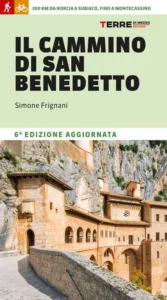
Journey diaries
Cammino di San Benedetto
With Cammini d’Italia’s free app, you can plan and walk The Cammino di San Benedetto safely, being able to plan the stages in detail and walk the route thanks to the built-in GPS technology that supports your orientation during your adventure.
⠀Inside the app you will find many other paths present in Italy. Thanks to the georeferenced tracks of many routes you will be able to study the itinerary that suits you best and also download the GPX tracks of the individual STAGEs offline.
The app also includes a complete digital map of all the paths surveyed to date on our portal, giving you a wide range of choices among the many paths in the Belpaese.
⠀⠀
Cammini d’Italia is the perfect app for those who want to explore the beauty of Italy on foot, discovering hidden places surrounded by nature. Download it for free today and start planning your next adventure!
⠀
⠀
